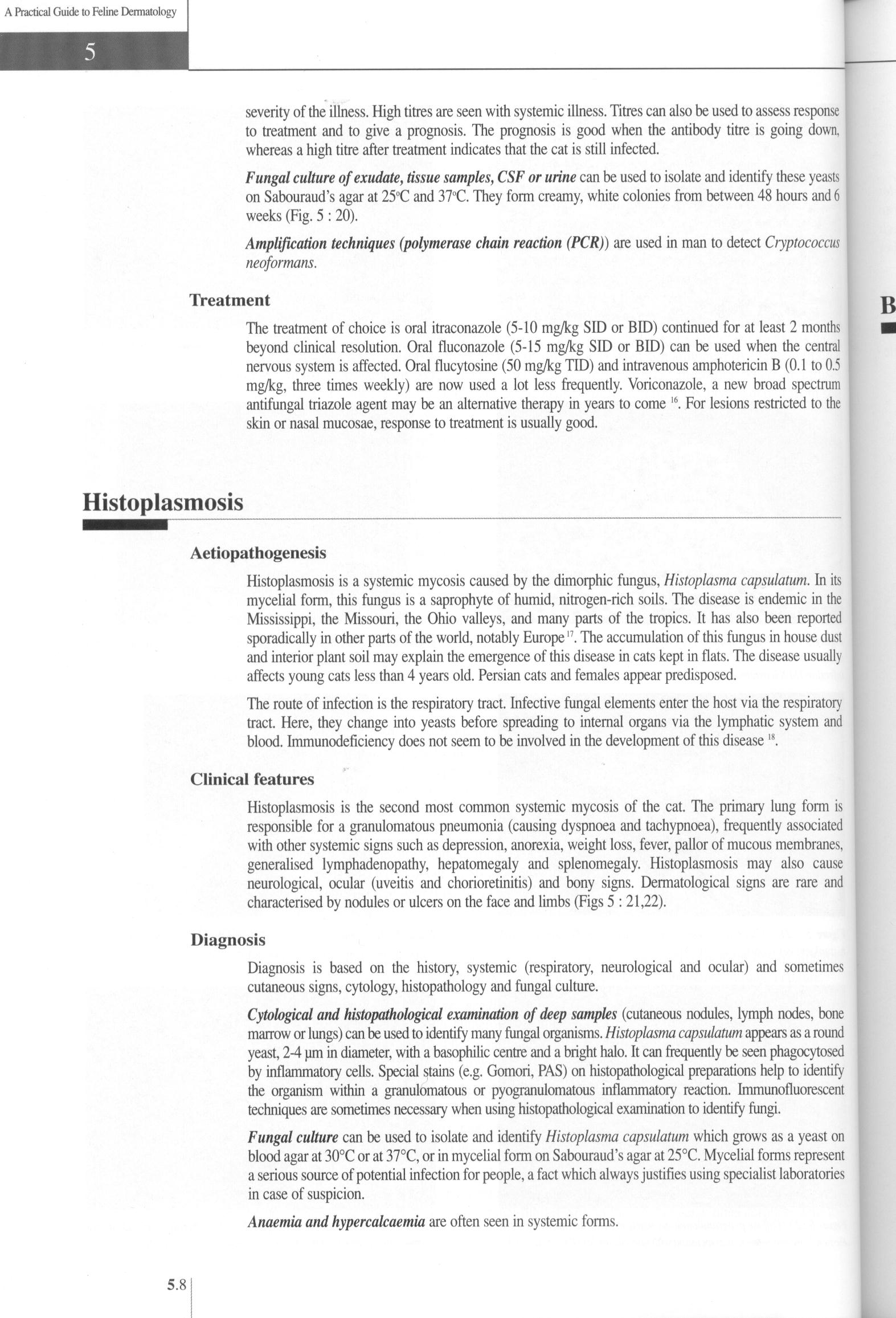58 (148)

5
A Practical Guide to Feline Dermatology
severity of the illness. High titres are seen with systemie illness. Titres can also be used to assess response to treatment and to give a prognosis. The prognosis is good when the antibody titre is going down, whereas a high titre after treatment indicates that the cat is still infected.
Fungal culture ofexudate, tissue samples, CSF or uńne can be used to isolate and identify these yeasts on Sabouraud’s agar at 25°C and 37°C. They form creamy, white colonies from between 48 hours and 6 weeks (Fig. 5 : 20).
Amplification techniąues (polymerase chain reaction (PCR)) are used in man to detect Cryptococcus neoformans.
B
Treatment
The treatment of choice is orał itraconazole (5-10 mg/kg SID or BID) continued for at least 2 months beyond clinical resolution. Orał fluconazołe (5-15 mg/kg SID or BID) can be used when the central nervous system is affected. Orał flucytosine (50 mg/kg TID) and intravenous amphotericin B (0.1 to 0.5 mg/kg, three times weekly) are now used a lot less ffeąuently. Voriconazole, a new broad speetmm antifungal triazole agent may be an altemative therapy in years to come l6. For lesions restricted to the skin or nasal mucosae, response to treatment is usually good.
Histoplasmosis
Aetiopathogenesis
Histoplasmosis is a systemie mycosis caused by the dimorphic fungus, Histoplasma capsulatum. In its mycelial form, this fungus is a saprophyte of humid, nitrogen-rich soils. The disease is endemic in the Mississippi, the Missouri, the Ohio valleys, and many parts of the tropics. It has also been reported sporadically in other parts of the world, notably Europęl7. The accumulation of this fungus in house dust and interior plant soil may explain the emergence of this disease in cats kept in flats. The disease usually affects young cats less than 4 years old. Persian cats and females appear predisposed.
The route of infection is the respiratory tract. Infective fungal elements enter the host via the respiratory tract. Here, they change into yeasts before spreading to intemal organs via the lymphatic system and blood. Immunodeficiency does not seem to be involved in the development of this disease18.
Clinical features
Histoplasmosis is the second most common systemie mycosis of the cat. The primary lung form is responsible for a granulomatous pneumonia (causing dyspnoea and tachypnoea), ffeąuently associated with other systemie signs such as depression, anorexia, weight loss, fever, pallor of mucous membranes, generalised lymphadenopathy, hepatomegaly and splenomegaly. Histoplasmosis may also cause neurological, ocular (uveitis and chorioretinitis) and bony signs. Dermatological signs are rare and characterised by nodules or uleers on the face and limbs (Figs 5 :21,22).
Diagnosis
Diagnosis is based on the history, systemie (respiratory, neurological and ocular) and sometimes cutaneous signs, cytology, histopathology and fungal culture.
Cytological and histopathological examination of deep samples (cutaneous nodules, lymph nodes, bonę marrow or lungs) can be used to identify many fungal organisms. Histoplasma capsulatum appears as a round yeast, 24 pm in diameter, with a basophilic centre and a bright halo. It can ffeąuently be seen phagocytosed by inflammatory cells. Special stains (e.g. Gomori, PAS) on histopathological preparations help to identify the organism within a granulomatous or pyogranulomatous inflammatory reaction. Immunofluorescent techniąues are sometimes necessary when using histopathological examination to identify fungi.
Fungal culture can be used to isolate and identify Histoplasma capsulatum which grows as a yeast on blood agar at 30°C or at 37°C, or in mycelial form on Sabouraud’s agar at 25°C. Mycelial forms represent a serious source of potential infection for people, a fact which always justifies using specialist laboratories in case of suspicion.
Anaemia and hypercalcaemia are often seen in systemie forms.
5.8
Wyszukiwarka
Podobne podstrony:
28 (374) 2 A Practical Guide to Feline Dermatology Configuration of lesions Determining the configur
236 (22) Practical Guide to Feline Dermatology23 observed on the whole body. Nodular lesions primari
248 (22) 24 A Practical Guide to Feline DermatologyDiagnostic tests Given the incidence of dermatoph
256 (18) 25 , Practical Guide to Feline Dermatology Prophylactic measures should, therefore, be take
65 (127) 6 A Practical Guide to Feline Dermatology Other topical antimicrobial agents, such as chlor
67 (125) 6 A Practical Guide to Feline DermatologyNocardiosisAetiopathogenesis Nocardiosis is a very
69 (119) 6 A Practical Guide to Feline DermatologyDiagnosis The diagnosis is based on lesion distrib
710 (2) 7 A Practical Guide to Feline DermatologyHerpesvirus infections Dermatological manifestation
74 (105) 7 A Practical Guide to Feline Dermatology ulcerated. Lesion distribution is multicentric bu
27 A Practical Guide to Feline Dermatology Perianal glands 1.7 Permethrin 3.12, 3.13 Persian 1.6,2.2
27 A Practical Guide to Feline Dermatology Stemphyllium spp. 5.1,7.8 Stereotypie behaviour 17.1,
272 (16) 27 A Practical Guide to Feline Dermatology Alternaria spp. 5.1,7.8 Aluminium hyroxide 15.6&
274 (18) 27 A Practical Guide to Feline Dermatology Colitis 11.2 Collagen 1.2,2.6,12.1,
278 (17) 27 A Practical Guide to Feline Dermatology I J Histoplasmosis 5.8, 7.8, 25.2 Homer’s syndro
313 (14) A Practical Guide to Feline Dermatology The second phase consists of long-term control of t
31 (328) 3 A Practical Guide to Feline Dermatology Sarcoptic mange Sarcoptes scabiei var canis (Tabl
82 (128) 8 A Practical Guide to Feline Dermatology considered important parasites. Cats in the Unite
42 (226) 4 A Practical Guide to Feline Dermatology Increased hydration and subsequent maceration of
44 (228) 4 A Practical Guide to Feline Dermatolog) The term “asymptomatically infected cat” refers
więcej podobnych podstron